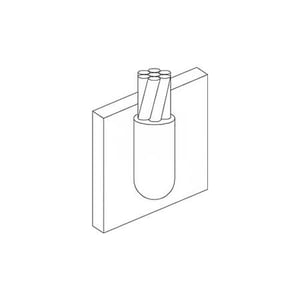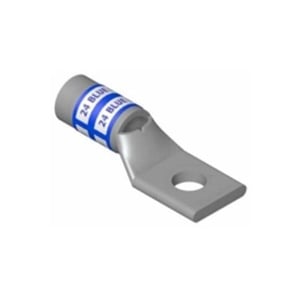Coaxial cables are electrical cables that transmit high radio frequency (RF) signals from point A to point B. Common applications include cable TV, cell boosters, and internet connectivity.
How Does Coaxial Cable Work?
Coax cables are used every day. The layers of electrical conductors and insulating material enclose the signals within the cable, ensuring that electrical noise doesn’t decrease signal strength and allowing smooth signal transmission that can be converted into many applications.
Advantages Of Coaxial Cable
Coax cables offer several advantages:
- Durable and reliable
- Easy to install and expand
- Resistance to electromagnetic interference
- Support high bandwidth
- Support multiple channels
Applications Of Coaxial Cable
Common applications for coax cables include:
- Television
- Internet
- Audio
- Signal boosters
- CCTV
- RF systems
- Video
Structure And Components Of Coaxial Cables
Coax cables come in different sizes and lengths but are composed of the same four elements:
Core: The core consists of a single copper or copper-coated wire that carries RF frequencies.
Dielectric insulator: Usually plastic, the insulator surrounds the core to provide space between the core and the next layer.
Shield: Usually woven metal, the shield(s) surround the insulator to provide a barrier against electromagnetic interference.
Jacket: The outermost layer, made of polymer and coated with plastic, protects the other three layers from damage.
Types Of Coaxial Cables
There are several different types of coax cables, each suited for different applications. Coaxial cables are separated into RG and LMR cables. LMR cables support a wider frequency range but are manufactured by one company. RG cables are widely available and come in a variety of options.
- RG-6 Coaxial Cable: RG-6 cables are commonly used for both commercial and residential applications like television, internet, and satellite.
- RG-11 Coaxial Cable: RG-11 cables are a good choice for applications requiring data to be carried a longer distance.
- RG-59 Coaxial Cable: RG-59 cables are great for low-frequency transmissions and short distances, like CCTV or analog video.
- Triaxial Cable: Triaxial cables have three conductors and an extra shield to protect against electromagnetic interference.
- Semi-Rigid Coaxial Cable: These cables use an all-copper outer sheath with an insulating outer sheath made of Polytetrafluoroethylene.
- Flexible Coaxial Cable: If a project is in a confined area or will be subject to a lot of movement, consider a flexible cable.
Coaxial Cable Connectors
Each end of a coax cable has a connector. These connect devices and protect the cable during transmissions.
- Subminiature Version A Connector: SMA connectors are minimal connector interfaces with screw-type coupling.
- Subminiature Version B Connector: SMB connectors are smaller versions of SMA connectors with snap-on coupling.
- F-Type Connector: These connectors are usually found on RG-6 cables and are common in residential cable applications.
- N-Type Connector: These larger connectors are commonly used in commercial cable applications.
- For Mobile Equipment Connector: FME connectors have a small diameter, making them ideal for applications in tight places.
- Threaded Neill-Coucelman Connector: TNC connectors are small, high-performing connectors that are weatherproof.
- UHF Connector: Not as universal as other connectors, the UHF is often used in amateur and citizen’s band radio applications.
Coaxial Cable For Audio And Video Applications
Precise construction allows cables to carry audio and video information to homes and businesses. Cables help with applications like antenna connections, cable TV, CCTV, digital audio systems, high-definition connections, and other audio and video applications.
Coaxial Cable For Data And Communications
Coax cables carry data from point A to Point B. They reduce the amount of electrical noise interfering with a signal.
- Coaxial Cable for Ethernet and Networking: Consider a coax-to-Ethernet adapter to speed up WiFi and have a better connection.
- Coaxial Cable for Internet and Broadband: R-6 cables offer an affordable high-speed broadband solution with wider frequency and higher bandwidth.
- Coaxial Cable for Cable Modems: Coax cables connect the back of the modem to a bolt-like outlet in the wall to communicate with the internet service provider (ISP).
Frequently Asked Questions About Coaxial Cables
Common questions about coaxial cables include:
How Far Can A Coaxial Cable Transmit Signals?
Transmission distance depends on factors including cable type, signal frequency, signal quality, signal loss, and signal boosting. Lower gauges transmit signals further than those with higher gauges.
Can I Use A Coaxial Cable For Internet Connections?
Connecting to the internet is one of the most common uses for coax cables. Data signals are sent through the coax cable to the modem. It is a great solution for homes, businesses, and multi-person properties because of its wide availability.
Is It Possible To Repair Damaged Coaxial Cable?
While it is always safer to replace the cable, there are ways to repair minor coaxial damages. However, it is critical to understand DIY repairs will often lead to signal loss and increased electromagnetic interference.






















